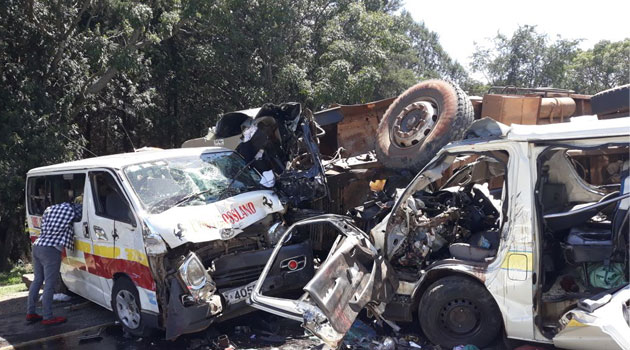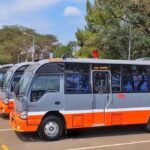Kenya’s roads, the arteries of our economy and connectors of our communities, have become a tragic battleground. In 2025, the nation continues to grapple with a persistent road safety crisis, with thousands of lives lost and countless families shattered. The recent press statement by Transport Cabinet Secretary Davis Chirchir, released on August 11, 2025, paints a grim picture: 2,933 fatalities recorded between January and August 10, 2025, with 80 deaths occurring in just four days. These numbers are not mere statistics—they represent loved ones, dreams extinguished, and communities in mourning. This article delves into the current state of road safety in Kenya, the devastating toll of road traffic crashes, the government’s response through the National Road Safety Action Plan 2024–2028, and ongoing infrastructure improvements like the Nithi Bridge redesign and Rironi-Mau Summit Road dualling. We explore the National Transport and Safety Authority’s (NTSA) initiatives, the challenges ahead, and how every Kenyan can contribute to safer roads.
The Alarming State of Road Safety in Kenya 2025
A Snapshot of Road Traffic Crashes: January to August 2025
The first eight months of 2025 have been marked by a troubling rise in road traffic crashes, claiming 2,933 lives by August 10, according to the Ministry of Roads and Transport. The National Transport and Safety Authority (NTSA) provides a detailed breakdown for the first quarter (January to March 31, 2025), reporting 1,139 fatalities—a slight decrease from 1,166 in the same period in 2024. Despite this marginal improvement, the numbers remain staggering, with:
- Pedestrians: 420 deaths, the highest among road users, though down from 434 in 2024.
- Motorcyclists: 301 fatalities, up from 274, signaling a worrying increase.
- Pillion passengers: 130 deaths, compared to 100 in 2024.
- Passengers: 189 deaths, a decrease from 243.
- Drivers: 83 fatalities, down from 94.
- Pedal cyclists: 16 deaths, a slight drop from 21.
Additionally, 5,856 people were involved in crashes during the first quarter, with 3,316 sustaining serious injuries and 2,693 suffering minor injuries. The recent spike of 80 deaths in four days underscores the urgency of addressing this crisis. Pedestrians and motorcyclists remain the most vulnerable, reflecting systemic issues in road design, driver behavior, and enforcement.
Economic and Social Toll of Road Carnage
The cost of road accidents extends beyond human lives. The National Road Safety Action Plan 2024–2028 estimates that road carnage drains Kenya’s economy by Sh450 billion annually, burdening families, healthcare systems, and emergency services. Trauma victims and their loved ones bear the brunt, while hospitals strain under the weight of treating crash-related injuries. This economic loss, coupled with the emotional devastation, demands urgent action to curb the rising tide of fatalities and injuries.
Kenya’s National Road Safety Action Plan 2024–2028: A Blueprint for Change
A Comprehensive Strategy to Halve Road Deaths
Launched on April 17, 2024, at the Kenyatta International Convention Centre (KICC) with President William Ruto and EU Ambassador Henriette Geiger in attendance, the National Road Safety Action Plan 2024–2028 is Kenya’s boldest attempt yet to reduce road deaths and serious injuries by half. The plan, developed by the Ministry of Roads and Transport through NTSA, integrates multiple pillars of road safety, including:
- Road Infrastructure Improvements: Enhancing road design to prioritize safety, such as eliminating black spots and improving pedestrian pathways.
- Vehicle Safety Standards: Enforcing stricter regulations on vehicle maintenance and roadworthiness.
- Stricter Enforcement: Cracking down on traffic violations like drunk driving and speeding.
- Public Awareness Campaigns: Promoting behavior change among drivers, pedestrians, and boda boda riders.
- Post-Crash Care: Strengthening emergency response systems to save lives after accidents.
- School Transport Regulations: Mandating regular inspections and driver retraining for school buses.
- Boda Boda Sector Regulation: Collaborating with county governments to regulate the 1.8 million active boda bodas, a critical yet high-risk transport sector.
- Technology Integration: Deploying speed cameras, instant fines, and surveillance at high-risk junctions.
The plan emphasizes driver education, dignified working conditions for drivers and riders (e.g., an eight-hour workday cap), and a national dialogue on road safety. By leveraging technology and stakeholder collaboration, it aims to create a safer road environment for all Kenyans.
Legislative Reforms to Bolster Enforcement
Transport Cabinet Secretary Davis Chirchir has highlighted advanced-stage efforts to strengthen road safety legislation. Key reforms include:
- School Transport: Regulations to limit operating hours and mandate regular inspections for school buses.
- Commercial Vehicles: Stricter oversight of public service vehicles (PSVs) and commercial fleets.
- Drunk Driving: Reintroducing breathalyzers to curb alcohol-related crashes, with 1,000 devices to be deployed nationwide.
- Vehicle Inspections: Enhancing standards to ensure roadworthiness.
- Traffic Act Review: Comprehensive updates to align with modern safety needs.
These reforms aim to address human error, a leading cause of crashes, and restore discipline on Kenya’s roads.
Infrastructure Upgrades: Nithi Bridge and Rironi-Mau Summit Road
Redesigning Nithi Bridge: Tackling a Notorious Black Spot
The Nithi Bridge, long considered one of Kenya’s deadliest black spots, is undergoing a significant redesign to enhance safety. This critical infrastructure project, nearing completion in 2025, addresses design flaws that have contributed to numerous fatal crashes. By improving road alignment, signage, and safety barriers, the redesign aims to reduce accidents and save lives. The government’s focus on such high-risk areas reflects a commitment to addressing infrastructure-related causes of road crashes.
Dualling the Rironi-Mau Summit Road
The ongoing dualling of the Rironi-Mau Summit Road is another flagship project aimed at improving road safety and traffic flow. This major artery, connecting Nairobi to western Kenya, has been plagued by congestion and accidents. The dualling project, expected to be completed soon, will increase capacity, reduce overtaking-related crashes, and incorporate safety features like pedestrian crossings and better signage. These improvements are critical to reducing the high crash rates on this corridor.
NTSA’s Road Safety Initiatives in 2025: Driving Change
Scaling Up Enforcement and Public Education
The NTSA is at the forefront of Kenya’s road safety efforts, coordinating initiatives to reduce crashes and change road user behavior. Key 2025 initiatives include:
- Nationwide Crackdowns: Targeting drunk driving, speeding, and improper parking, with a focus on PSVs lacking speed governors.
- Public Awareness Campaigns: Educating drivers, pedestrians, and boda boda riders on safety guidelines and traffic rules.
- Breathalyzer Reintroduction: Deploying 1,000 breathalyzers to curb drunk driving, a major cause of fatal crashes.
- Speed Governor Enforcement: Ensuring all PSVs comply with mandatory speed governor installation.
- Boda Boda Regulation: Collaborating with county governments to regulate the 2.5 million registered boda bodas, addressing their role in rising fatalities.
Recent Tragedies Highlight the Urgency
Recent incidents, such as the Kisumu-Kakamega Highway crash involving a Naki High School bus and another at Korompoi along the Kitengela-Isinya Road, have sparked public outrage. These tragedies, claiming 26 and eight lives respectively, underscore the need for immediate action. NTSA’s condolence statement and commitment to investigate these crashes reflect its role in both enforcement and empathy.
Challenges in Achieving Road Safety Goals
Despite progress, Kenya risks missing its road safety targets. In 2024, over 4,700 people died in road crashes, and 2025’s figures suggest the trend persists. Key challenges include:
- Road User Indiscipline: Drunk driving, speeding, and overloading remain prevalent, as seen in the Sotik crash involving a vehicle with over 20 passengers.
- Infrastructure Gaps: While projects like Nithi Bridge and Rironi-Mau Summit are underway, many roads still lack adequate safety features.
- Boda Boda Sector: The rapid growth of boda bodas, with 1.8 million active units, poses regulatory challenges due to inconsistent county-level enforcement.
- Public Awareness: Changing entrenched behaviors among drivers, pedestrians, and cyclists requires sustained education efforts.
- Resource Constraints: Implementing the National Road Safety Action Plan within available resources is a significant hurdle.
A Collective Responsibility: What Kenyans Can Do
As Cabinet Secretary Chirchir emphasized, road traffic accidents are predictable and preventable if all road users play their part. Here’s how Kenyans can contribute:
- Drivers: Adhere to speed limits, avoid drunk driving, and ensure vehicles are roadworthy with functional speed governors.
- Pedestrians: Use designated crossings, stay vigilant, and avoid distractions like mobile phones while crossing roads.
- Boda Boda Riders: Wear helmets, follow traffic rules, and avoid overloading or reckless riding.
- Cyclists: Use reflective gear, obey traffic signals, and ride in designated lanes where available.
- Passengers: Refuse to board overloaded or unsafe vehicles and report reckless drivers to NTSA.
- Community Advocacy: Support local road safety campaigns and hold leaders accountable for infrastructure improvements.
Kenya’s road safety crisis in 2025 demands urgent, collective action. The National Road Safety Action Plan 2024–2028, coupled with infrastructure upgrades like the Nithi Bridge redesign and Rironi-Mau Summit Road dualling, offers hope for reducing the staggering toll of 2,933 fatalities recorded by August 10. NTSA’s initiatives, from breathalyzer deployment to public education, are critical steps toward safer roads. However, the success of these measures hinges on every Kenyan’s commitment to responsible road use. As we mourn the lives lost, let us honor them by building a future where Kenya’s roads are safe for all. Join the movement—prioritize safety, follow traffic rules, and advocate for change. Together, we can make 2025 a turning point in Kenya’s road safety journey.





